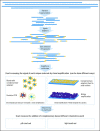Cancer genomics and inherited risk
- PMID: 24449244
- PMCID: PMC5795694
- DOI: 10.1200/JCO.2013.49.7271
Cancer genomics and inherited risk
Abstract
Next-generation sequencing (NGS) has enabled whole-exome and whole-genome sequencing of tumors for causative mutations, allowing for more accurate targeting of therapies. In the process of sequencing the tumor, comparisons to the germline genome may identify variants associated with susceptibility to cancer as well as other hereditary diseases. Already, the combination of massively parallel sequencing and selective capture approaches has facilitated efficient simultaneous genetic analysis (multiplex testing) of large numbers of candidate genes. As the field of oncology incorporates NGS approaches into tumor and germline analyses, it has become clear that the ability to achieve high-throughput genotyping surpasses our current ability to interpret and appropriately apply the vast amounts of data generated from such technologies. A review of the current state of knowledge of rare and common genetic variants associated with cancer risk or treatment outcome reveals significant progress, as well as a number of challenges associated with the clinical translation of these discoveries. The combined efforts of oncologists, genetic counselors, and cancer geneticists will be required to drive the paradigm shift toward personalized or precision medicine and to ensure the incorporation of NGS technologies into the practice of preventive oncology.
Conflict of interest statement
Authors' disclosures of potential conflicts of interest and author contributions are found at the end of this article.
Figures





References
-
- Garber JE, Offit K: Hereditary cancer predisposition syndromes J Clin Oncol 23: 276– 292,2005. - PubMed
-
- Robson M, Offit K: Clinical practice: Management of an inherited predisposition to breast cancer N Engl J Med 357: 154– 162,2007. - PubMed
-
- Lindor NM Petersen GM Hadley DW , etal: Recommendations for the care of individuals with an inherited predisposition to Lynch syndrome: A systematic review JAMA 296: 1507– 1517,2006. - PubMed
-
- Galiatsatos P, Foulkes WD: Familial adenomatous polyposis Am J Gastroenterol 101: 385– 398,2006. - PubMed
-
- Villani A Tabori U Schiffman J , etal: Biochemical and imaging surveillance in germline TP53 mutation carriers with Li-Fraumeni syndrome: A prospective observational study Lancet Oncol 12: 559– 567,2011. - PubMed
Publication types
MeSH terms
Grants and funding
LinkOut - more resources
Full Text Sources
Other Literature Sources
Medical
Research Materials

